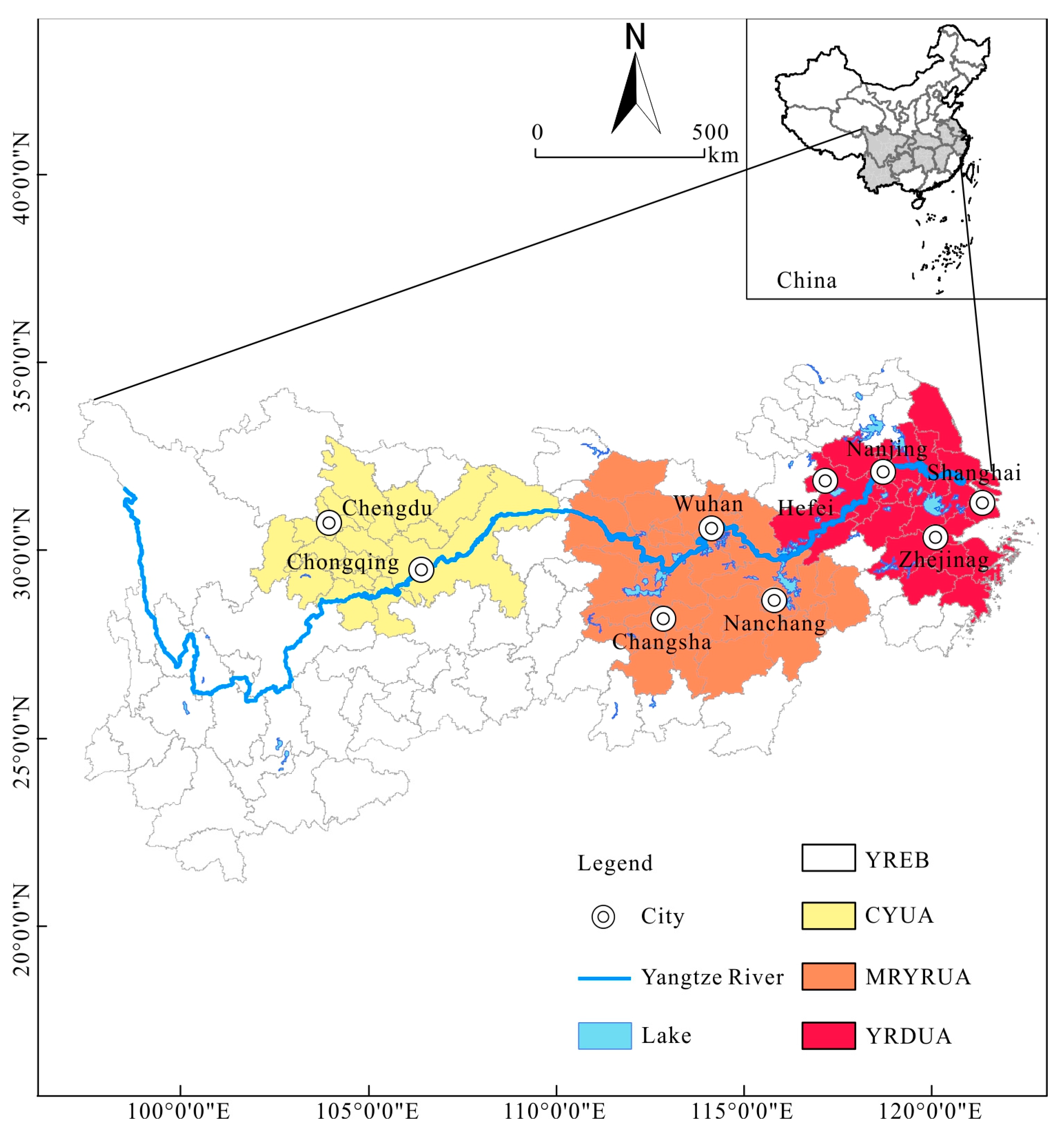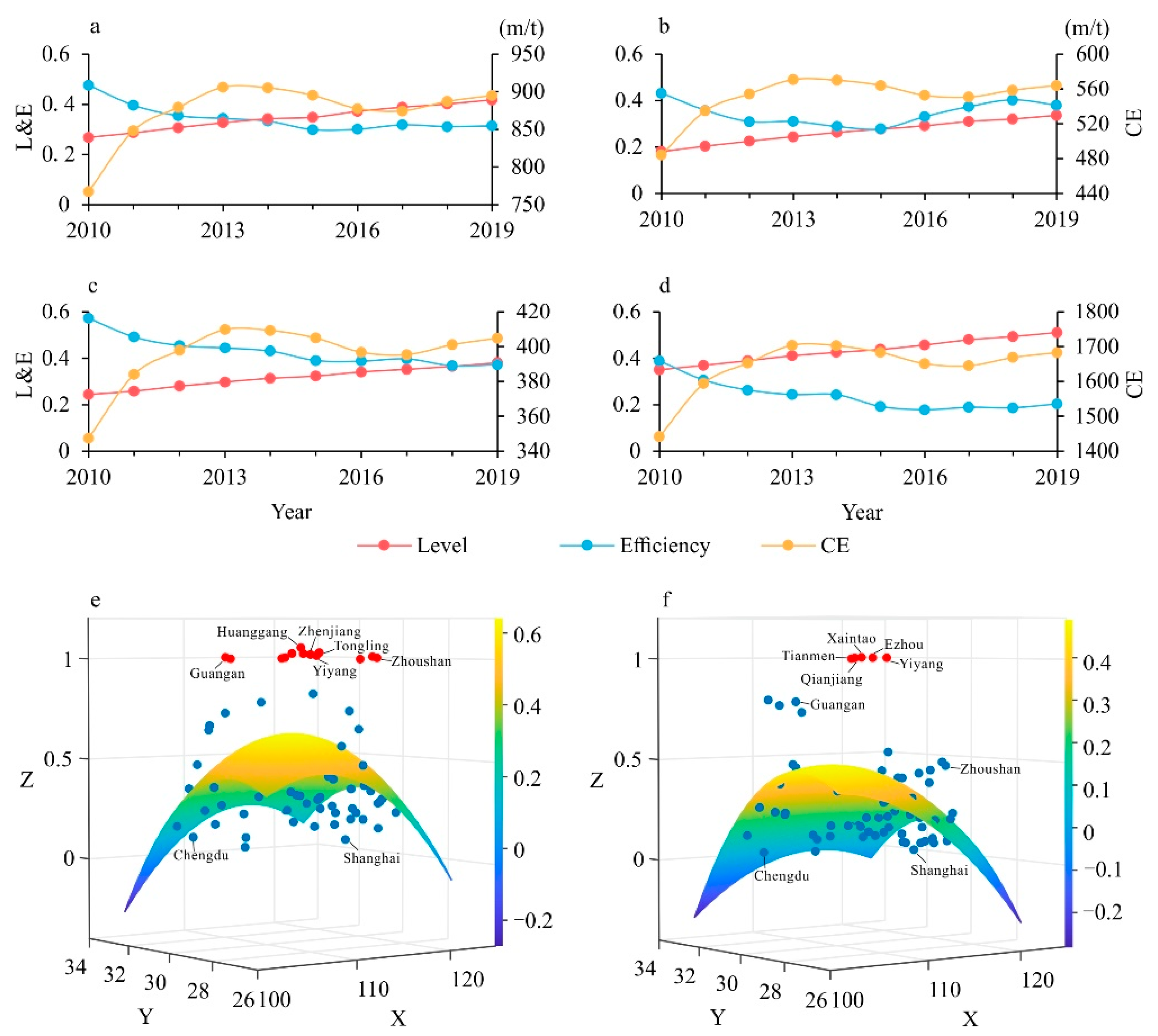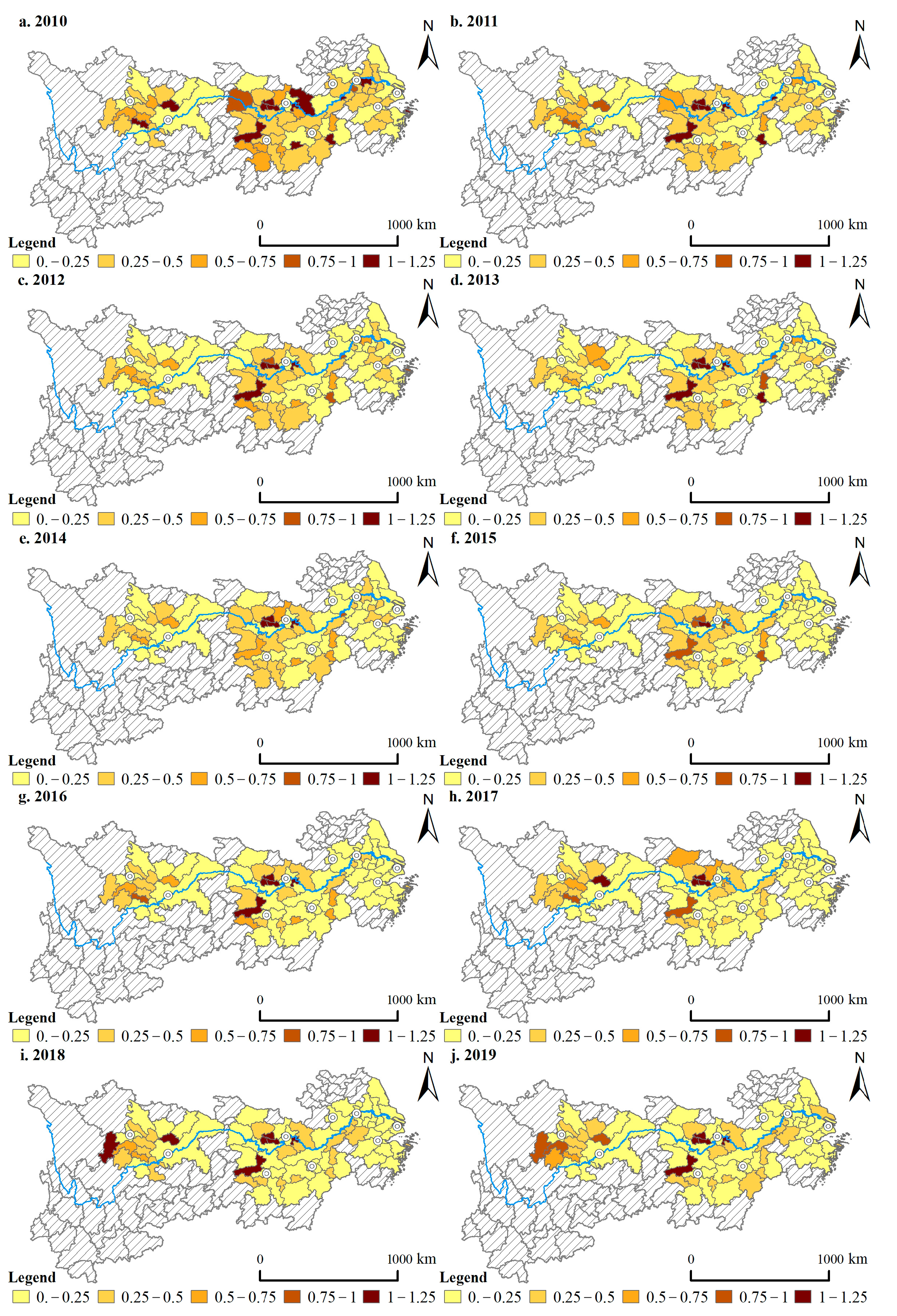The Efficiency of Urban–Rural Integration in the Yangtze River Economic Belt and Its Optimization
Abstract
1. Introduction
2. Materials and Methods
2.1. Study Area
2.2. Materials
2.3. Methods
2.3.1. Evaluation of URID Efficiency
- Efficiency measurement index system
- 2.
- The EBM superefficiency model
2.3.2. Evaluation of the URID Level
- Level measurement index system
- 2.
- Vertical and horizontal scatter degree method
2.3.3. Evaluation of the URID Level
3. Results
3.1. General Change Characteristics in the Efficiency of URID
3.2. Evolution of the Spatiotemporal Pattern of URID Efficiency at the City Level
4. Discussion
4.1. Analysis of the Changing Law of URID Efficiency
4.1.1. Analysis of the Overall Laws of Change for URID Efficiency
4.1.2. Analysis of the Change Pattern of URID Efficiency at the City Cluster Level
4.2. Correlation between Carbon Emissions and URID Efficiency
4.3. Improvement of URID Efficiency
4.3.1. Input–Output Analysis of URID Efficiency
4.3.2. URID Efficiency Input–Output Path Optimization
5. Conclusions
Author Contributions
Funding
Institutional Review Board Statement
Informed Consent Statement
Data Availability Statement
Conflicts of Interest
References
- Liu, Y.; Zang, Y.; Yang, Y. China’s rural revitalization and development: Theory, technology and management. J. Geogr. Sci. 2020, 30, 1923–1942. [Google Scholar] [CrossRef]
- Li, Y.H.; Jia, L.R.; Wu, W.H.; Yan, J.Y.; Liu, Y.S. Urbanization for rural sustainability-Rethinking China’s urbanization strategy. J. Clean. Prod. 2018, 178, 580–586. [Google Scholar] [CrossRef]
- Liu, Y.S.; Li, Y.H. Revitalize the world’s countryside. Nature 2017, 548, 275–277. [Google Scholar] [CrossRef] [PubMed]
- Zhang, Z.; Lu, Y. China’s urban-rural relationship: Evolution and prospects. China Agric. Econ. Rev. 2018, 10, 260–276. [Google Scholar] [CrossRef]
- Su, C.; Liu, T.; Chang, H.; Jiang, X. Is urbanization narrowing the urban-rural income gap? A cross-regional study of China. Habitat Int. 2015, 48, 79–86. [Google Scholar] [CrossRef]
- Shi, J.G.; Yan, H.M. Implementation efficiency of urban-rural development integration is measured and suggested. J. Tongji Univ. 2014, 25, 67–74. (In Chinese) [Google Scholar]
- Charnes, A.W.; Cooper, W.W.; Rhodes, E.L. Measuring the Efficiency of Decision Making Units. Eur. J. Oper. Res. 1979, 2, 429–444. [Google Scholar] [CrossRef]
- Banker, R.D. Some models for estimating technical and scale inefficiencies in data envelopmentanalysis. Manag. Sci. 1984, 30, 1078–1092. [Google Scholar] [CrossRef]
- Afonso, A.; Fernandes, S. Measuring local government spending efficiency: Evidence for the Lisbon region. Reg. Stud. 2006, 40, 39–53. [Google Scholar] [CrossRef]
- Kalseth, J.; Rattsø, J. Spending and overspending in local government administration: A minimum requirement approach applied to Norway. Eur. J. Polit. Econ. 1995, 11, 239–251. [Google Scholar] [CrossRef]
- Alam, I.M.S.; Sickles, R.C. The Relationship Between Stock Market Returns and Technical Efficiency Innovations: Evidence from the US Airline Industry. J. Prod. Anal. 1998, 9, 35–51. [Google Scholar] [CrossRef]
- Yörük, B.K.; Zaim, O. Productivity growth in OECD countries: A comparison with Malmquist indices. J. Comp. Econ. 2005, 33, 401–420. [Google Scholar] [CrossRef]
- Fulginiti, L.E.; Perrin, R.K. Agricultural productivity in developing countries. Agric. Econ. 1998, 19, 45–51. [Google Scholar] [CrossRef]
- Fertner, C. Downscaling European urban-rural typologies. Geogr. Tidsskr. 2012, 112, 77–83. [Google Scholar] [CrossRef]
- Fertner, C. The Emergence and Consolidation of the Urban-Rural Region: Migration Patterns around Copenhagen 1986–2011. Tijdschr. Econ. Soc. Geogr. 2013, 104, 322–337. [Google Scholar] [CrossRef]
- Serra, P.; Vera, A.; Tulla, A.F.; Salvati, L. Beyond urban–rural dichotomy: Exploring socioeconomic and land-use processes of change in Spain (1991–2011). Appl. Geogr. 2014, 55, 71–81. [Google Scholar] [CrossRef]
- Caffyn, A.; Dahlström, M. Urban-rural interdependencies: Joining up policy in practice. Reg. Stud. 2005, 39, 283–296. [Google Scholar] [CrossRef]
- Lundh, C.; Prado, S. Markets and politics: The Swedish urban-rural wage gap, 1865–1985. Eur. Rev. Econ. Hist. 2015, 19, 67–87. [Google Scholar] [CrossRef]
- Xiao, L.; He, Z.; Wang, Y.; Guo, Q. Understanding urban-rural linkages from an ecological perspective. Int. J. Sust. Dev. World 2017, 24, 37–43. [Google Scholar] [CrossRef]
- Tang, D.; Bethel, B.J. Yangtze River Economic Belt environmental remediation efficiency based on an input-output optimization analysis. Environ. Sci. Pollut. Res. 2021, 28, 16734–16743. [Google Scholar] [CrossRef]
- Chen, K.Z.; Mao, R.; Zhou, Y. Rurbanomics for common prosperity: New approach to integrated urban-rural development. China Agric. Econ. Rev. 2022. ahead of print. [Google Scholar] [CrossRef]
- Liu, Y.; Schen, C.; Li, Y. Differentiation regularity of urban-rural equalized development at prefecture-level city in China. J. Geogr. Sci. 2015, 25, 1075–1088. [Google Scholar] [CrossRef]
- Liu, Y.; Lu, S.; Chen, Y. Spatio-temporal change of urban-rural equalized development patterns in China and its driving factors. J. Rural Stud. 2013, 32, 320–330. [Google Scholar] [CrossRef]
- Yang, Y.; Bao, W.; Wang, Y.; Liu, Y. Measurement of urban-rural integration level and its spatial differentiation in China in the new century. Habitat Int. 2021, 117, 102420. [Google Scholar] [CrossRef]
- Du, B.; Wang, Y.; He, J.; Li, W.; Chen, X. Spatio-Temporal Characteristics and Obstacle Factors of the Urban-Rural Integration of China’s Shrinking Cities in the Context of Sustainable Development. Sustainability 2021, 13, 4203. [Google Scholar] [CrossRef]
- Wu, X.; Cui, P. A Study of the Time-Space Evolution Characteristics of Urban-Rural Integration Development in a Mountainous Area Based on ESDA-GIS: The Case of the Qinling-Daba Mountains in China. Sustainability 2016, 8, 1085. [Google Scholar] [CrossRef]
- Zheng, Y.; Tan, J.; Huang, Y.; Wang, Z. The Governance Path of Urban-Rural Integration in Changing Urban-Rural Relationships in the Metropolitan Area: A Case Study of Wuhan, China. Land 2022, 11, 1334. [Google Scholar] [CrossRef]
- Chen, C.; LeGates, R.; Zhao, M.; Fang, C. The changing rural-urban divide in China’s megacities. Cities 2018, 81, 81–90. [Google Scholar] [CrossRef]
- Chen, K.; Long, H.; Liao, L.; Tu, S.; Li, T. Land use transitions and urban-rural integrated development: Theoretical framework and China’s evidence. Land Use Policy 2020, 92, 104465. [Google Scholar] [CrossRef]
- Tian, Y.; Qian, J.; Wang, L. Village classification in metropolitan suburbs from the perspective of urban-rural integration and improvement strategies: A case study of Wuhan, central China. Land Use Policy 2021, 111, 105748. [Google Scholar] [CrossRef]
- Yang, L.; Zhao, F.C. Evaluation of urban-rural integration development efficiency based on DEA technology. Inq. Into Econ. Issues 2010, 6, 8–13. (In Chinese) [Google Scholar]
- Cao, Y.; Yu, F.; Kang, Y.F. Urban and rural overall planning evaluation based on integrated AHP/DEA method. Stat. Decis. 2011, 24, 58–60. (In Chinese) [Google Scholar]
- Yan, H.M.; Shi, J.K. Efficiency evaluation of my country’s provincial local governments coordinating urban and rural development-based on DEA analysis at the provincial level. Issues Agric. Econ. 2014, 35, 94–102. (In Chinese) [Google Scholar]
- Hu, Y.G.; Liao, C.Q.; Zhang, X.M.; Wang, C. Evaluation of overall urban and rural development efficiency based on data envelopment analysis. City Plan. Rev. 2016, 40, 46–50. (In Chinese) [Google Scholar]
- Pan, J.H.; Yin, J. Evaluation and spatial difference analysis of urban and rural development efficiency in Gansu Province based on DEA-ESDA. Econ. Geogr. 2011, 31, 1439–1444. (In Chinese) [Google Scholar]
- Yin, J.; Tan, Q.M.; Wu, X.L. Evaluation of urban and rural overall planning efficiency and its spatial spillover effect in Jiangsu Province. Chin. J. Agric. Res. Reg. Plan. 2018, 39, 76–182. (In Chinese) [Google Scholar]
- Shi, J.G.; Duan, K.F.; Wu, G.D.; Li, J. Efficiency of urban-rural integration development in the Yangtze River Delta under the background of carbon emission constraint. Econ. Geogr. 2021, 41, 57–67. (In Chinese) [Google Scholar]
- Fang, C.L.; Zhou, C.H.; Wang, Z.B. Strategic issues of sustainable development of urban agglomerations in the Yangtze River Economic Belt and key points of grading and gradient development. Prog. Geogr. 2015, 34, 1398–1408. (In Chinese) [Google Scholar]
- Cai, B.; Shao, Z.; Fang, S.; Huang, X.; Tang, Y.; Zheng, M.; Zhang, H. The Evolution of urban agglomerations in China and how it deviates from Zipf’s law. Geo-Spat. Inf. Sci. 2022, 1–11. [Google Scholar] [CrossRef]
- Oda, T.; Maksyutov, S.; Andres, R.J. The Open-source Data Inventory for Anthropogenic CO2, version 2016 (ODIAC2016): A global monthly fossil fuel CO2 griddede missions data product for tracer transport simulations and surface flux inversions. Earth Syst. Sci. Data 2018, 10, 87–107. [Google Scholar] [CrossRef]
- Tone, K. A slacks-based measure of super-efficiency in data envelopment analysis. Eur. J. Oper. Res. 2002, 143, 32–41. [Google Scholar] [CrossRef]
- Tone, K.; Tsutsui, M. An epsilon-based measure of efficiency in DEA-A third pole of technical efficiency. Eur. J. Oper. Res. 2010, 207, 1554–1563. [Google Scholar]
- Zhou, J.L.; Qin, F.C.; Liu, J.; Zhu, G.L.; Zou, W. Measurement, spatiotemporal evolution and influence mechanism of urban-rural integration level in China from a multi-dimensional perspective. Chin. J. Popul. Resour. Environ. 2019, 29, 166–176. (In Chinese) [Google Scholar]
- Shi, J.G.; Duan, K.F.; Wu, G.D. Measurement of urban-rural integration development level in the Yangtze River Delta and analysis of its spatiotemporal characteristics. J. Tongji Univ. 2022, 33, 78–89. (In Chinese) [Google Scholar]
- Cai, B.; Shao, Z.; Fang, S.; Huang, X.; Huq, M.E.; Tang, Y.; Li, Y.; Zhuang, Q. Finer-scale spatiotemporal coupling coordination model between socioeconomic activity and eco-environment: A case study of Beijing, China. Ecol. Indic. 2021, 131, 108165. [Google Scholar] [CrossRef]
- Liu, Y.; Long, H.; Chen, Y.; Wang, J.; Li Yurui Li Yuheng Yang, Y.; Zhou, Y. Progress of research on urban-rural transformation and rural development in China in the past decade and future prospects. J. Geogr. Sci. 2016, 26, 1117–1132. [Google Scholar]
- Liu, Y.; Zhou, Y.; Li, Y. Rural regional system and rural revitalization strategy in China. Acta Geogr. Sin. 2019, 74, 2511–2528. (In Chinese) [Google Scholar]
- Guo, Y.J. A New Dynamic Comprehensive Evaluation Method. J. Manag. Sci. China 2002, 2, 49–54. (In Chinese) [Google Scholar]
- Yi, P.T.; Zhang, D.N.; Guo, Y.J.; Gao, L.Q. Dimensionless Method in Dynamic Comprehensive Evaluation. J. China Univ. 2009, 30, 889–892. (In Chinese) [Google Scholar]
- Xia, Y.L. Exploring the intelligent path of community governance under the leadership of party building-Taking the “Community Link” in Baoshan, Shanghai as an example. SHH. Pty. Hist. Pty. Bldg. 2018, 11, 54–57. (In Chinese) [Google Scholar]
- Liu, J.X.; Zeng, S. Intellectual property, top-level design and exploration practice of digital governance in rural China. J. Lanzhou Univ. 2020, 48, 64–71. (In Chinese) [Google Scholar]




| Index Attribute | Index Selection | ID |
|---|---|---|
| Input indicators | Education (100 million yuan) | Ip1 |
| Science and technology (100 million yuan) | Ip2 | |
| Culture, sports, and media (100 million yuan) | Ip3 | |
| Social security and employment (100 million yuan) | Ip4 | |
| Hygiene and health (100 million yuan) | Ip5 | |
| Energy conservation and environmental protection (100 million yuan) | Ip6 | |
| Urban and rural communities (100 million yuan) | Ip7 | |
| Agriculture, forest, and water (100 million yuan) | Ip8 | |
| Public transportation (100 million yuan) | Ip9 | |
| Business services (100 million yuan) | Ip10 | |
| Expenditure on housing security (100 million yuan) | Ip11 | |
| Output indicators | The level of integrated urban and rural development | Op1 |
| Carbon emission efficiency (ton/10,000) | Op2 | |
| Carbon emissions (10,000 tons) | Op3 |
| Dimensionality | Indicator Name | Indicator Calculation and Description | Attribute | Category |
|---|---|---|---|---|
| Economic integration | Per capita GDP | GDP/regional resident population (yuan) | + | Comprehensive |
| Disposable income ratio of urban and rural residents | Per capita disposable income of urban residents/per capita disposable income of rural residents (%) | Comparison | ||
| Per capita consumption ratio of urban and rural households | Per capita consumption expenditure of urban residents/per capita consumption expenditure of rural residents (%) | Comparison | ||
| Engel’s coefficient ratio between urban and rural areas | Urban Engel’s coefficient/rural Engel’s coefficient (%) | + | Comparison | |
| Binary contrast coefficient | (Output value of primary industry/employees of primary industry)/(output value of secondary and tertiary industries/employees of secondary and tertiary industries) (%) | + | Comparison | |
| Social integration | Urban and rural cultural, educational and entertainment comparison coefficient | Per capita expenditure on cultural, educational and recreational services for urban residents/per capita expenditure on cultural, educational and recreational services for rural residents (%) | Comparison | |
| Teacher–student ratio in basic education | Number of elementary education teachers/number of elementary education students (%) | + | Comprehensive | |
| Contrast coefficient of medical care per capita between urban and rural areas | Per capita health care expenditure of urban residents/per capita health care expenditure of rural residents (%) | Comparison | ||
| Urban and rural unemployment insurance coverage | Number of urban and rural residents covered by unemployment insurance/number of permanent residents (%) | + | Comprehensive | |
| Population integration | Urban and rural population contrast coefficient | Urban population/rural population (%) | + | Comparison |
| The ratio of nonagricultural employment to agricultural employment | Number of employees in the secondary and tertiary industries/number of employees in the primary industry/(%) | + | Comparison | |
| Population urbanization level | Total urban population/total population (%) | + | Comprehensive | |
| Ecological integration | Vegetation index | Urban and rural NDVA (normalized difference vegetation index) | + | Comprehensive |
| Urban and rural sewage treatment | Centralized treatment rate of sewage treatment plant (%) | + | Comprehensive | |
| Urban and rural domestic waste treatment | Harmless treatment rate of domestic waste (%) | + | Comprehensive | |
| Space integration | Road network density | Highway operating mileage/total land area (km/km2) | + | Comprehensive |
| Urban and rural internet user rate | Number of internet users in urban and rural areas/total number of households at the end of the year (%) | + | Comprehensive |
| City | Input Redundancy Rate | Underproduction (Redundancy) Rate | ||||||||||||
|---|---|---|---|---|---|---|---|---|---|---|---|---|---|---|
| Ip1 | Ip2 | Ip3 | Ip4 | Ip5 | Ip6 | Ip7 | Ip8 | Ip9 | Ip10 | Ip11 | Op1 | Op2 | Op3 | |
| CYUA | −0.69 | −0.54 | −0.79 | −0.71 | −0.74 | −0.80 | −0.78 | −0.70 | −0.66 | −0.63 | −0.85 | 0.54 | 1.42 | −0.62 |
| MRYRUA | −0.57 | −0.58 | −0.59 | −0.59 | −0.54 | −0.62 | −0.68 | −0.53 | −0.51 | −0.53 | −0.60 | 0.45 | 1.38 | −0.54 |
| YRDUA | −0.76 | −0.87 | −0.82 | −0.66 | −0.70 | −0.76 | −0.90 | −0.67 | −0.68 | −0.71 | −0.77 | 0.60 | 3.91 | −0.78 |
| Average value | −0.66 | −0.68 | −0.71 | −0.64 | −0.64 | −0.71 | −0.78 | −0.62 | −0.60 | −0.62 | −0.71 | 0.52 | 2.29 | −0.64 |
Disclaimer/Publisher’s Note: The statements, opinions and data contained in all publications are solely those of the individual author(s) and contributor(s) and not of MDPI and/or the editor(s). MDPI and/or the editor(s) disclaim responsibility for any injury to people or property resulting from any ideas, methods, instructions or products referred to in the content. |
© 2023 by the authors. Licensee MDPI, Basel, Switzerland. This article is an open access article distributed under the terms and conditions of the Creative Commons Attribution (CC BY) license (https://creativecommons.org/licenses/by/4.0/).
Share and Cite
Muga, G.; Hu, S.; Wang, Z.; Tong, L.; Hu, Z.; Huang, H.; Qu, S. The Efficiency of Urban–Rural Integration in the Yangtze River Economic Belt and Its Optimization. Sustainability 2023, 15, 2419. https://doi.org/10.3390/su15032419
Muga G, Hu S, Wang Z, Tong L, Hu Z, Huang H, Qu S. The Efficiency of Urban–Rural Integration in the Yangtze River Economic Belt and Its Optimization. Sustainability. 2023; 15(3):2419. https://doi.org/10.3390/su15032419
Chicago/Turabian StyleMuga, Gubu, Shougeng Hu, Zhilan Wang, Luyi Tong, Zongnan Hu, Hui Huang, and Shijin Qu. 2023. "The Efficiency of Urban–Rural Integration in the Yangtze River Economic Belt and Its Optimization" Sustainability 15, no. 3: 2419. https://doi.org/10.3390/su15032419
APA StyleMuga, G., Hu, S., Wang, Z., Tong, L., Hu, Z., Huang, H., & Qu, S. (2023). The Efficiency of Urban–Rural Integration in the Yangtze River Economic Belt and Its Optimization. Sustainability, 15(3), 2419. https://doi.org/10.3390/su15032419










